
The Varkud satellite (VS) ribozyme is an RNA enzyme that carries out the cleavage of a phosphodiester bond. [1] [2]

The Varkud satellite (VS) ribozyme is an RNA enzyme that carries out the cleavage of a phosphodiester bond. [1] [2]
Varkud satellite (VS) ribozyme is the largest known nucleolytic ribozyme and found to be embedded in VS RNA. VS RNA is a long non-coding RNA exists as a satellite RNA and is found in mitochondria of Varkud-1C and few other strains of Neurospora . VS ribozyme contains features of both catalytic RNAs and group 1 introns. [3] VS ribozyme has both cleavage and ligation activity and can perform both cleavage and ligation reactions efficiently in the absence of proteins. VS ribozyme undergo horizontal gene transfer with other Neurospora strains. [4] VS ribozymes have nothing in common with other nucleolytic ribozymes.
VS RNA has a unique primary, secondary, and tertiary structure. The secondary structure of the VS ribozyme consists of six helical domains (Figure 1). Stem loop I forms the substrate domain while stem-loop II-VI forms the catalytic domain. When these 2 domains are synthesized in vitro separately, they can perform the self-cleavage reaction by trans-acting [5] The substrate binds into a cleft which is made by two helices. The likely active site of the ribozyme is a very important nucleotide A756. The A730 loop and A756 nucleotide are critical to its function since they participate in the phosphoric transfer chemistry activity of the ribozyme [6]
VS RNA is transcribed as a multimeric transcript from VS DNA. VS DNA contains a region coding reverse transcriptase necessary for replication of the VS RNA. Once transcribed VS RNA undergoes a site specific cleavage. VS RNA self-cleaves at a specific phosphodiester bond to produce a monomeric and few multimeric transcripts. These transcripts then undergo a self-ligation and form a circular VS RNA. [7] This circular VS RNA is the predominant form of VS found in Neurospora. VS ribozyme is a small catalytic motif embedded within this circular VS RNA. The majority of VS RNA is made up of 881 nucleotides [7]
In the natural state, a VS ribozyme motif contains 154 nucleotides that fold into six helices. Its RNA contains a self-cleavage element which is thought to act in the processing of intermediates made through the process of replication. [8] The H-shaped structure of the ribozyme is organized by two three-way junctions which determine the overall fold of the ribozyme. A unique feature of the structure of ribozyme is that even if the majority of helix IV and distal end of helix VI would be deleted there would be no significant loss of activity [9] However, if the lengths of helix III and V were to be changed there would be major loss of activity. The base bulges of the ribozyme, helices II and IV have very important structural roles since replacing them with other nucleotides does not affect their activity. Basically, VS ribozyme's activity is very dependent on the local sequence of the two three-way junctions. The three-way junction present in the VS ribozyme is very similar to the one seen in the small (23S) subunit of rRNA. [9]
The active sites of the ribozyme can be found in the helical junctions, the bulges and the lengths of the critical helices those being III and V. There is one important area found in the internal loop of helix VI called A730, a single base change in this loop would lead to decreased loss of cleavage activity but no significant changes in the folding of the ribozyme occur. Other mutations which affect the activity of the ribozyme are methylation, suppression of thiophilic Manganese ions at the A730 site [10]
The A730 loop is very important in the catalytic activity of the ribozyme. The ribozyme functions like a docking station where it will dock the substrate into the cleft between helices II and VI to facilitate an interaction between the cleavage site and A730 loop. This interaction makes an environment to which catalysis can proceed in a way similar to interactions seen in the hairpin ribozyme. Within the A730 loop, a substitution of A756 by G, C or U will lead to a 300-fold loss of cleavage and ligation activity.
The proof that A730 loop is the active site of the VS ribozyme is very evident, and that A756 plays an important role in its activity. The cleavage reaction works by an SN2 reaction mechanism. The nucleophilic attack of the 2’-oxygen on the 3’-phosphate will create a cyclic 2’3’ phosphate by the 5’-oxygen leaving. The ligation reaction occurs in reverse in which the 5’-oxygen attacks the 3’-phosphate of the cyclic phosphate. [11] The way that both of these reactions are facilitated is by general acid-base catalysis which strengthen the oxygen nucleophile by removing bonded proteins and stabilizing the oxyanion leaving groups through protonation. It is also important to add that if a group is behaving as a base in the cleavage reaction then it must act as an acid in the ligation reaction. Solvated metal ions act in general acid-base catalysis, where the metal ions might act as a Lewis acid which polarize phosphate oxygen atoms. Another important factor in the rate of ligation reaction is the pH dependence which corresponds to a pKa of 5.6, which is not a factor in the cleavage reaction . This particular dependence requires a protonated base at position A756 of the ribozyme.
Another proposed catalytic strategy is the stabilization of a pentavalent phosphate of the reaction transition state. This mechanism would probably involve the formation of hydrogen bonds as seen in the hairpin ribozyme [12] Furthermore, the proximity of active site groups to each other and their orientation in space would contribute to the catalytic mechanism taking place. This might bring the transition state and the substrate closer for the legation reaction to occur.
Very high concentration of bivalent and monovalent cation increase the efficiency of the cleavage reaction. These cations facilitate the base pairing of the ribozyme with the substrate. [3] VS cleavage rate can be accelerated by high cation concentration as well as by increasing RNA concentration. Therefore, a low concentration of any of these is rate-limiting. The cations' role is considered to be charge neutralizing in the folding of RNA rather than acting as a catalyst.
1. A molecular fossil of RNA world which has retained both cleavage and ligation functions.
2. VS Ribozyme later acquired one or more of its enzymatic activities.
RNA mediated cleavage and ligation is found in group 1 and group 2 self-splicing RNAs. VS RNA contains many conserved sequence characteristics to group 1 introns. However VS ribozyme splice site is different from group 1 intron splice site and VR ribozyme self-cleaving site is outside of the core of the group 1 intron. In the cleavage reaction VS ribozyme produce 2’,3’ -cyclic phosphate and the group 1 introns produce 3’-hydroxyl. Functional similarity with group 1 introns and then mechanistically being different from the introns support this hypothesis that VS ribozyme is a chimera formed by insertion of a novel catalytic RNA into group 1 introns. [1] [2]
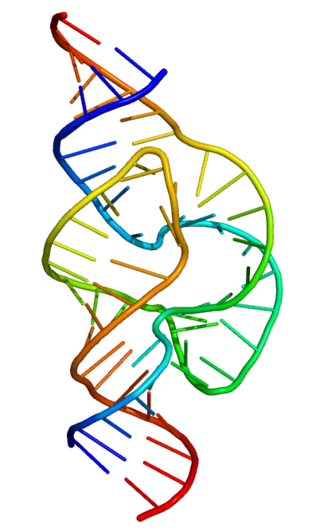
Ribozymes are RNA molecules that have the ability to catalyze specific biochemical reactions, including RNA splicing in gene expression, similar to the action of protein enzymes. The 1982 discovery of ribozymes demonstrated that RNA can be both genetic material and a biological catalyst, and contributed to the RNA world hypothesis, which suggests that RNA may have been important in the evolution of prebiotic self-replicating systems.
Deoxyribozymes, also called DNA enzymes, DNAzymes, or catalytic DNA, are DNA oligonucleotides that are capable of performing a specific chemical reaction, often but not always catalytic. This is similar to the action of other biological enzymes, such as proteins or ribozymes . However, in contrast to the abundance of protein enzymes in biological systems and the discovery of biological ribozymes in the 1980s, there is only little evidence for naturally occurring deoxyribozymes. Deoxyribozymes should not be confused with DNA aptamers which are oligonucleotides that selectively bind a target ligand, but do not catalyze a subsequent chemical reaction.

Stem-loop intramolecular base pairing is a pattern that can occur in single-stranded RNA. The structure is also known as a hairpin or hairpin loop. It occurs when two regions of the same strand, usually complementary in nucleotide sequence when read in opposite directions, base-pair to form a double helix that ends in an unpaired loop. The resulting structure is a key building block of many RNA secondary structures. As an important secondary structure of RNA, it can direct RNA folding, protect structural stability for messenger RNA (mRNA), provide recognition sites for RNA binding proteins, and serve as a substrate for enzymatic reactions.
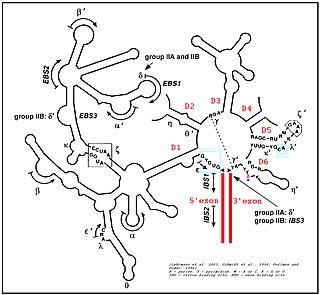
Group II introns are a large class of self-catalytic ribozymes and mobile genetic elements found within the genes of all three domains of life. Ribozyme activity can occur under high-salt conditions in vitro. However, assistance from proteins is required for in vivo splicing. In contrast to group I introns, intron excision occurs in the absence of GTP and involves the formation of a lariat, with an A-residue branchpoint strongly resembling that found in lariats formed during splicing of nuclear pre-mRNA. It is hypothesized that pre-mRNA splicing may have evolved from group II introns, due to the similar catalytic mechanism as well as the structural similarity of the Group II Domain V substructure to the U6/U2 extended snRNA. Finally, their ability to site-specifically insert into DNA sites has been exploited as a tool for biotechnology. For example, group II introns can be modified to make site-specific genome insertions and deliver cargo DNA such as reporter genes or lox sites

The hammerhead ribozyme is an RNA motif that catalyzes reversible cleavage and ligation reactions at a specific site within an RNA molecule. It is one of several catalytic RNAs (ribozymes) known to occur in nature. It serves as a model system for research on the structure and properties of RNA, and is used for targeted RNA cleavage experiments, some with proposed therapeutic applications. Named for the resemblance of early secondary structure diagrams to a hammerhead shark, hammerhead ribozymes were originally discovered in two classes of plant virus-like RNAs: satellite RNAs and viroids. They are also known in some classes of retrotransposons, including the retrozymes. The hammerhead ribozyme motif has been ubiquitously reported in lineages across the tree of life.

The hairpin ribozyme is a small section of RNA that can act as a ribozyme. Like the hammerhead ribozyme it is found in RNA satellites of plant viruses. It was first identified in the minus strand of the tobacco ringspot virus (TRSV) satellite RNA where it catalyzes self-cleavage and joining (ligation) reactions to process the products of rolling circle virus replication into linear and circular satellite RNA molecules. The hairpin ribozyme is similar to the hammerhead ribozyme in that it does not require a metal ion for the reaction.

Leadzyme is a small ribozyme (catalytic RNA), which catalyzes the cleavage of a specific phosphodiester bond. It was discovered using an in-vitro evolution study where the researchers were selecting for RNAs that specifically cleaved themselves in the presence of lead. However, since then, it has been discovered in several natural systems. Leadzyme was found to be efficient and dynamic in the presence of micromolar concentrations of lead ions. Unlike in other small self-cleaving ribozymes, other divalent metal ions cannot replace Pb2+ in the leadzyme. Due to obligatory requirement for a lead, the ribozyme is called a metalloribozyme.

The glucosamine-6-phosphate riboswitch ribozyme is an RNA structure that resides in the 5' untranslated region (UTR) of the mRNA transcript of the glmS gene. This RNA regulates the glmS gene by responding to concentrations of a specific metabolite, glucosamine-6-phosphate (GlcN6P), in addition to catalyzing a self-cleaving chemical reaction upon activation. This cleavage leads to the degradation of the mRNA that contains the ribozyme, and lowers production of GlcN6P. The glmS gene encodes for an enzyme glutamine-fructose-6-phosphate amidotransferase, which catalyzes the formation of GlcN6P, a compound essential for cell wall biosynthesis, from fructose-6-phosphate and glutamine. Thus, when GlcN6P levels are high, the glmS ribozyme is activated and the mRNA transcript is degraded but in the absence of GlcN6P the gene continues to be translated into glutamine-fructose-6-phosphate amidotransferase and GlcN6P is produced. GlcN6P is a cofactor for this cleavage reaction, as it directly participates as an acid-base catalyst. This RNA is the first riboswitch also found to be a self-cleaving ribozyme and, like many others, was discovered using a bioinformatics approach.
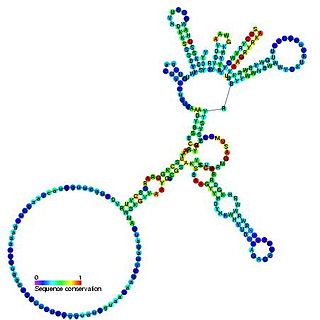
Group I introns are large self-splicing ribozymes. They catalyze their own excision from mRNA, tRNA and rRNA precursors in a wide range of organisms. The core secondary structure consists of nine paired regions (P1-P9). These fold to essentially two domains – the P4-P6 domain and the P3-P9 domain. The secondary structure mark-up for this family represents only this conserved core. Group I introns often have long open reading frames inserted in loop regions.

The hepatitis delta virus (HDV) ribozyme is a non-coding RNA found in the hepatitis delta virus that is necessary for viral replication and is the only known human virus that utilizes ribozyme activity to infect its host. The ribozyme acts to process the RNA transcripts to unit lengths in a self-cleavage reaction during replication of the hepatitis delta virus, which is thought to propagate by a double rolling circle mechanism. The ribozyme is active in vivo in the absence of any protein factors and was the fastest known naturally occurring self-cleaving RNA at the time of its discovery.

Nuclease S1 is an endonuclease enzyme that splits single-stranded DNA (ssDNA) and RNA into oligo- or mononucleotides. This enzyme catalyses the following chemical reaction
The Lariat capping ribozyme is a ~180 nt ribozyme with an apparent resemblance to a group I ribozyme. It is found within a complex type of group I introns also termed twin-ribozyme introns. Rather than splicing, it catalyses a branching reaction in which the 2'OH of an internal residue is involved in a nucleophilic attack at a nearby phosphodiester bond. As a result, the RNA is cleaved at an internal processing site (IPS), leaving a 3'OH and a downstream product with a 3 nt lariat at its 5' end. The lariat has the first and the third nucleotide joined by a 2',5' phosphodiester bond and is referred to as 'the lariat cap' because it caps an intron-encoded mRNA. The resulting lariat cap seems to contribute by increasing the half-life of the HE mRNA, thus conferring an evolutionary advantage to the HE.
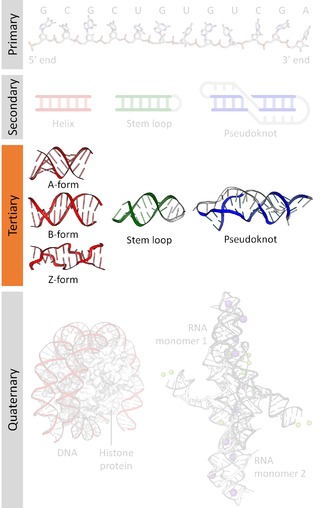
Nucleic acid tertiary structure is the three-dimensional shape of a nucleic acid polymer. RNA and DNA molecules are capable of diverse functions ranging from molecular recognition to catalysis. Such functions require a precise three-dimensional structure. While such structures are diverse and seemingly complex, they are composed of recurring, easily recognizable tertiary structural motifs that serve as molecular building blocks. Some of the most common motifs for RNA and DNA tertiary structure are described below, but this information is based on a limited number of solved structures. Many more tertiary structural motifs will be revealed as new RNA and DNA molecules are structurally characterized.
tRNA-intron lyase is an enzyme. As an endonuclease enzyme, tRNA-intron lyase is responsible for splicing phosphodiester bonds within non-coding ribonucleic acid chains. These non-coding RNA molecules form tRNA molecules after being processed, and this is dependent on tRNA-intron lyase to splice the pretRNA. tRNA processing is an important post-transcriptional modification necessary for tRNA maturation because it locates and removes introns in the pretRNA. This enzyme catalyses the following chemical reaction:

The twister ribozyme is a catalytic RNA structure capable of self-cleavage. The nucleolytic activity of this ribozyme has been demonstrated both in vivo and in vitro and has one of the fastest catalytic rates of naturally occurring ribozymes with similar function. The twister ribozyme is considered to be a member of the small self-cleaving ribozyme family which includes the hammerhead, hairpin, hepatitis delta virus (HDV), Varkud satellite (VS), and glmS ribozymes.

RNA hydrolysis is a reaction in which a phosphodiester bond in the sugar-phosphate backbone of RNA is broken, cleaving the RNA molecule. RNA is susceptible to this base-catalyzed hydrolysis because the ribose sugar in RNA has a hydroxyl group at the 2’ position. This feature makes RNA chemically unstable compared to DNA, which does not have this 2’ -OH group and thus is not susceptible to base-catalyzed hydrolysis.
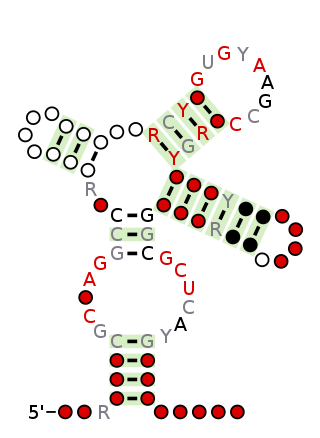
The twister sister ribozyme (TS) is an RNA structure that catalyzes its own cleavage at a specific site. In other words, it is a self-cleaving ribozyme. The twister sister ribozyme was discovered by a bioinformatics strategy as an RNA Associated with Genes Associated with Twister and Hammerhead ribozymes, or RAGATH.
The pistol ribozyme is an RNA structure that catalyzes its own cleavage at a specific site. In other words, it is a self-cleaving ribozyme. The pistol ribozyme was discovered through comparative genomic analysis. Subsequent biochemical analysis determined further biochemical characteristics of the ribozyme. This understanding was further advanced by an atomic-resolution crystal structure of a pistol ribozyme

Background: The hatchet ribozyme is an RNA structure that catalyzes its own cleavage at a specific site. In other words, it is a self-cleaving ribozyme. Hatchet ribozymes were discovered by a bioinformatics strategy as RNAs Associated with Genes Associated with Twister and Hammerhead ribozymes, or RAGATH.

Hovlinc RNA is a self-cleaving ribozyme of about 168 nucleotides found in a very long noncoding RNA (vlincRNA) in humans, chimpanzees, and gorillas. The word "hovlinc" comes from "hominin vlincRNA-located" RNA. Hovlinc is only a fourth known case of a ribozyme in human. Self-cleavage activity of Hovlinc has been shown in human, chimpanzees and bonobos, but is absent in gorillas, raising questions about Hovlinc's biological function and evolution.
{{cite book}}: CS1 maint: location missing publisher (link)